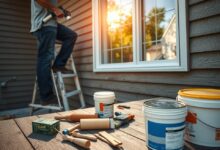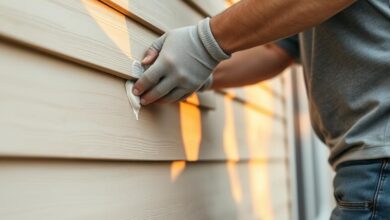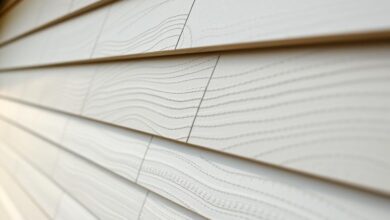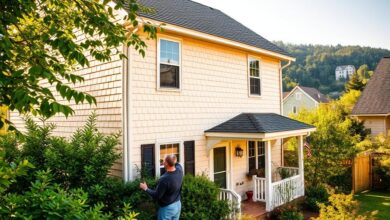Insulated Siding Maintenance: Keep Your Home Cozy
Maintaining insulated siding is key to a cozy and energy-efficient home. It keeps your siding working right, protecting your home from bad weather.
Looking after insulated siding makes your home’s exterior last longer and saves energy. A well-kept siding stops heat from escaping in winter and keeps your home cool in summer.
Key Takeaways
- Regular cleaning is essential for maintaining insulated siding.
- Inspect your siding regularly for damage or wear.
- Proper maintenance can enhance energy efficiency.
- Durability of siding is improved with regular upkeep.
- Cozy homes are a result of well-maintained insulated siding.
Understanding Insulated Siding and Its Benefits
Insulated siding is a big deal for homeowners wanting to make their homes more energy-efficient and durable. It’s a siding that has insulation built into it. This makes it a great choice for keeping your home’s exterior in top shape.
What Makes Insulated Siding Different
Insulated siding has insulation on the back of the siding material. This helps keep your home’s temperature steady. It means you use less energy for heating and cooling.
Energy Efficiency Advantages
Insulated siding is great for saving energy. It cuts down on heat loss, which saves you money on your bills. The U.S. Department of Energy says insulation can cut energy costs by up to 30%. The National Association of Home Builders also says it’s a smart investment for your home’s energy use.
| Benefits | Description | Impact |
|---|---|---|
| Energy Savings | Reduced heat transfer | Lower utility bills |
| Enhanced Durability | Resistant to weathering | Longer lifespan |
Weather Resistance Properties
Insulated siding also stands up better to the weather than regular siding. The insulation helps protect the siding from extreme temperatures. This means less chance of it cracking or warping.
Experts say insulated siding is a durable and easy-to-maintain choice. It’s perfect for homes in areas with harsh weather.
In short, insulated siding is a smart choice for homeowners. It’s good for saving energy and withstanding the weather. It’s a solid investment for any home.
How to Maintain Insulated Siding: Essential Practices
Keeping your insulated siding in good shape is key to a cozy and energy-efficient home. Regular care boosts your siding’s durability and keeps it looking great. It also helps it stay energy-efficient.
Seasonal Inspection Routines
Seasonal checks are important to spot problems early. Look for damage like cracks, dents, or gaps. Make sure all siding panels are tight.
Proper Cleaning Techniques
Cleaning your siding often keeps it looking good and working right. Use a gentle soap and water mix. Avoid harsh chemicals or rough cleaners that can harm the siding. For hard stains, try a vinyl siding cleaning product made for this.
Addressing Minor Damage Promptly
Fixing small damage quickly stops it from getting worse. Use a siding repair kit for small cracks or holes. Check your siding often for wear and do siding maintenance when needed.
| Maintenance Task | Frequency | Benefits |
|---|---|---|
| Seasonal Inspections | Every 3 months | Early detection of damage |
| Cleaning | Twice a year | Maintains appearance and functionality |
| Repairing Minor Damage | As needed | Prevents further damage |
Top Cleaning Products for Insulated Siding
To keep your insulated siding looking great, you need the right cleaning products. There are many cleaning solutions for different types of insulated siding.
Vinyl Siding Cleaners
Overview
Vinyl siding cleaners are made to remove dirt, grime, and mildew from vinyl without damage. They come in spray bottles or concentrates.
Pros
- Effective at removing tough stains and grime
- Specifically formulated for vinyl, ensuring safety and compatibility
- Easy to apply and rinse
Cons
- May contain harsh chemicals
- Some products might not be suitable for colored vinyl siding
Eco-Friendly Cleaning Solutions
Overview
Eco-friendly cleaning solutions use natural ingredients. They are safer for the environment and your family’s health. They clean insulated siding without harsh chemicals.
Pros
- Environmentally friendly and biodegradable
- Safe for use around pets and children
- Gentle on siding materials
Cons
- May not be as effective on tough stains
- Can be more expensive than traditional cleaners
Pressure Washing Equipment
Overview
Pressure washing uses high-pressure water jets to clean siding. It’s great for removing stubborn dirt and grime but must be used carefully to avoid damage.
Pros
- Highly effective for deep cleaning
- Can be used on various types of siding
Cons
- Risk of damaging siding if not used correctly
- Requires caution and sometimes professional expertise
| Cleaning Product | Effectiveness | Environmental Impact |
|---|---|---|
| Vinyl Siding Cleaners | High | Moderate |
| Eco-Friendly Solutions | Moderate | Low |
| Pressure Washing | High | Low |
A siding expert says, “Using the right cleaning products can significantly extend the life of your insulated siding.”
“The key to maintaining your siding is regular cleaning with the appropriate products. It’s not just about appearance; it’s about protecting your investment.”
Repair Products and Tools for Insulated Siding
Keeping your home’s insulated siding in top shape is key. The right repair products and tools are essential. Insulated siding is known for saving energy and lasting long, but it needs special materials for repairs.
Siding Repair Kits
Overview
Siding repair kits are made for homeowners to fix common problems like cracks and holes. They come with patching compounds, sealants, and sometimes extra pieces.
Pros
- They’re handy because they have everything you need for a fix
- They’re often cheaper than hiring a pro
Cons
- They might not work for big damage
- Quality can differ between brands
Caulking and Sealing Products
Overview
Caulking and sealing products are key for insulated siding. They stop moisture and air leaks.
Pros
- They’re simple to use for DIY fans
- They keep water out and save energy
Cons
- They might need to be reapplied over time
- Finding the right one can be tricky without the right info
Replacement Panel Options
Overview
For serious damage, you might need new panels. These panels match your siding, keeping it looking the same.
Pros
- They fix damaged siding for good
- There are many styles and materials to fit your siding
Cons
- They cost more than repair kits or caulking
- Professional installation might be needed for a perfect fit
Knowing about the different repair products and tools helps homeowners take care of their insulated siding. This keeps it looking and working well for many years.
Common Insulated Siding Problems and Solutions
Insulated siding can face issues if not cared for. Homeowners might see problems, but knowing them helps keep siding looking good. It also keeps the home strong.
Moisture and Mold Issues
Moisture can cause mold on insulated siding. Make sure your home drains well and has good air flow. Check your siding for moisture damage often. Clean it with a mix of bleach and water.
Cracking and Warping
Cracks and warps can happen from too much heat or bad installation. For small cracks, use a repair kit. Big warps might need new panels.
Insulation Degradation
The insulation in siding can break down over time. This makes it less effective. Look for signs like higher energy bills or drafts. If it’s bad, you might need new siding.
Color Fading and Restoration
Insulated siding can fade from sunlight. Use a siding cleaner made for your type to fix this. For really faded siding, you might need to repaint or replace it.
Knowing these common issues and fixes helps homeowners keep their siding in great shape. It makes the exterior of their home look good and last longer.
Professional vs. DIY Maintenance: Cost-Benefit Analysis
Choosing between professional maintenance and DIY for insulated siding depends on several factors. These include cost, complexity, and personal preference. It’s important to know when to call the pros and when to DIY for effective maintenance.
When to Call the Professionals
Tasks like fixing big damage, dealing with mold, or replacing big parts of siding are best left to pros. They have the right skills and tools to do these jobs well and safely.
DIY Maintenance Tasks Anyone Can Do
Homeowners can handle simple tasks like checking the siding, cleaning it, and fixing small damage. These tasks save money and help spot problems early.
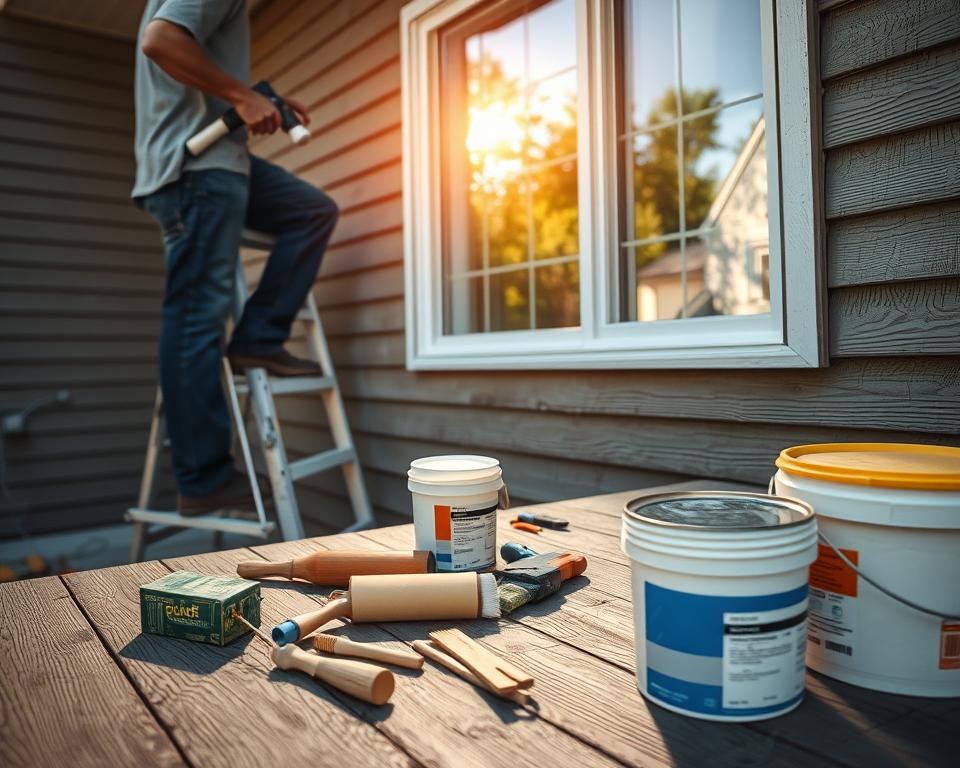
Cost Comparison and ROI
DIY maintenance might save money upfront. But, professional services can save more in the long run. They prevent expensive repairs and keep the siding in good shape for longer.
Recommended Service Providers
If you need professional help, choose reputable service providers. Look for companies with good reviews, experience, and the right licenses. This ensures quality work.
Conclusion: Keeping Your Home Cozy Year-Round
Keeping your home’s insulated siding in good shape is key to staying cozy all year. By following the tips in this article, your home will stay energy-efficient and safe from the weather.
Regular checks, cleaning right, and fixing small issues fast are important. This routine keeps your home cozy and saves you money on repairs. It also makes your home more comfortable.
Putting in the effort to care for your insulated siding means a cozy home all year. Whether you do it yourself or get help from pros, you’ll see the difference in your bills and comfort.
Start taking care of your home’s coziness with these easy tips. With regular maintenance, your insulated siding will keep your home warm and weather-proof for many years.



